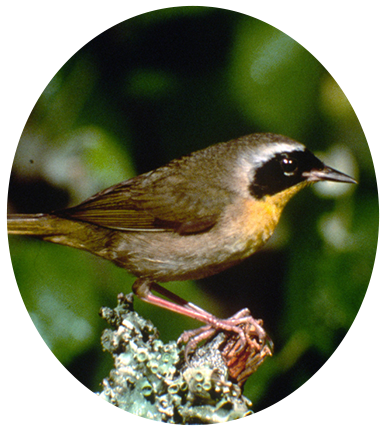

SCIENTIFIC NAME: Geothlypis trichas


The Common Yellowthroat is a small songbird with chunky rounded head and medium-length, slightly rounded tail. It is an abundant breeder in North America.

Both sexes measure about 4.3 - 5.1 inches in length, with a wingspan of 5.9 - 7.5 inches and weight of 9 - 10 grams.
They have olive backs, wings and tails, yellow throats and chests, and white bellies. They have short, sharp and black bill, pinkish legs and often shows a pale yellowish frequently incomplete eye ring.
Adult males have a facial black mask bordered above and behind by a whitish- gray band, and bright yellow throat and breast. They have a white belly and undertail coverts.
Adult females and many young males are brownish-olive above and buffy yellow below, with yellow wash only on throat, center of upper breast and undertail coverts. Flanks and sides of breast are pale buffy brown.
Female and young lacks the black facial mask, only beginning on the first winter bird.

CALL: A sharp, husky “chep” or “tchuck” repeatedly uttered as bird moves through vegetation.
SONG: A loud, rolling, but rather variable “witchity-witchity” when it’s flying.

They are generally insectivorous. They feed on leaves for insects and its larvae’s, such as grasshoppers, dragonflies, beetles, butterflies and spiders. They also eat seeds sometimes.

Found in bushes, rushes, and other low cover by marshes, pools and streams, or in brushy pastures, roadsides, woodland edges and regenerating woodlands.

Breeds in Alaska, and from Atlantic to Pacific Ocean, across Canada and US.
Winters from southern US to northern South America, and into the West Indies. They migrate only for food, when insects are harder to find.

The female builds a loose bulky cup- shaped nest made with a variety of materials including grasses, sedges, bark, ferns, rootlets and hair. It is lined with fine black rootlets and fine grasses.
She lays 3 - 5 brown eggs with black spots and incubates them for about 12 days.

SOURCES:
https://www.allaboutbirds.org
http://www.oiseaux-birds.com
https://en.wikipedia.org